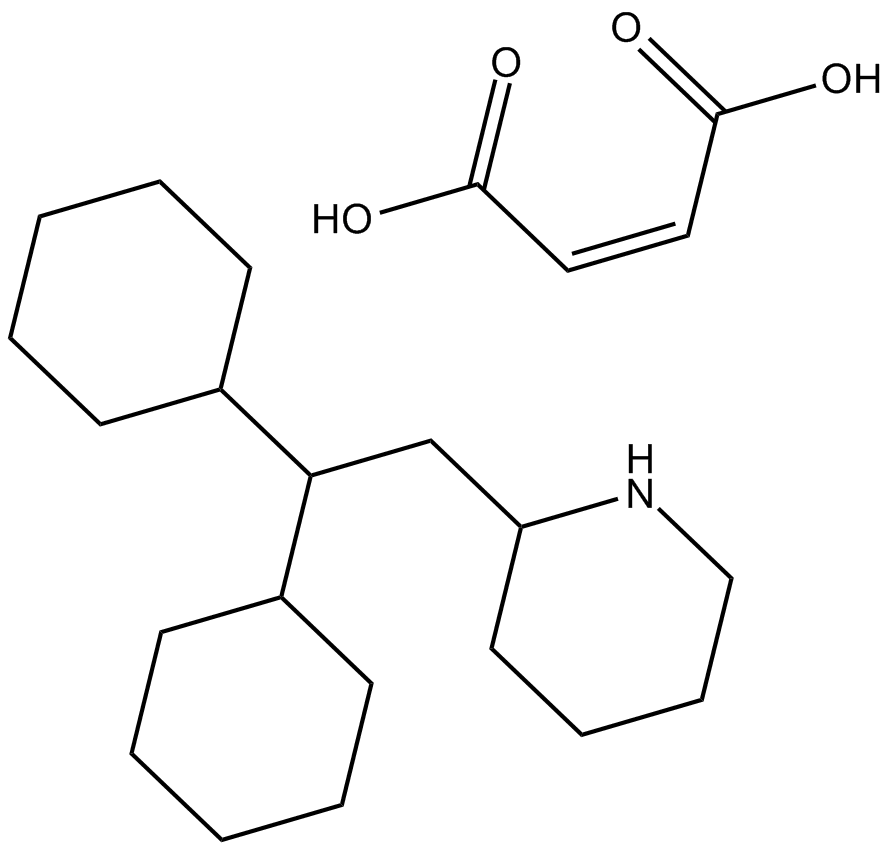Perhexiline (maleate) |
| Catalog No.GC15257 |
La perhexiline (maléate) est un inhibiteur de CPT1 et CPT2 actif par voie orale qui réduit le métabolisme des acides gras.
Products are for research use only. Not for human use. We do not sell to patients.

Cas No.: 6724-53-4
Sample solution is provided at 25 µL, 10mM.
Perhexiline maleate, an anti-anginal metabolic modulator, blocks the mitochondrial enzyme carnitine palmitoyltransferase 1 (CPT1) and to a lesser extent CPT2, which triggers causes a shift in myocardial substrate utilization from long chain fatty acids to carbohydrates, leading to the increased glucose and lactate utilization and increased ATP production for the same O2 consumption and consequently improves myocardial efficiency.
CPT1 and CPT2 are mitochondrial enzymes which oxidize long-chain fatty acids in the mitochondria. Additionally, perhexiline maleate is found to suppress the activity of Mammalian target of rapamycin complex 1 (mTORC1) which controls the initiation step of protein synthesis via the phosphorylation of eukaryotic initiation factor 4E-binding proteins and of ribosomal S6 kinases.
In vitro: Perhexiline maleate concentration-dependently and competitively inhibited CPT1 in rat cardiac and hepatic mitochondria, with an IC50 value of 77 and 148 μM, respectively. It was indicated that perhexiline maleate displayed a greater sensitivity of the cardiac than the hepatic enzyme when exhibiting inhibition effect [1]. Perhexiline maleate produced concentration-dependent inhibition of CPT2 activity with an IC50 value of 79 μM [2]. In human breast cancer MCF-7 cells, Perhexiline maleate blocked mTORC1 signaling at 10 μM and elicited autophagy ~7-fold at a concentration of 10 μM [3].
In vivo: Adult mice of Swiss NMRI strain were orally administrated with perhexiline maleate at a dosage of 100 mg/kg body weight/day for 10 weeks. Perhexiline maleate triggered changes in nerve, including a few cytoplasmic inclusions in Schwann and perineurial cells of mice treated with perhexiline maleate. After 11 weeks of administration of the drug, and up to 18 weeks, small abnormal zones were displayed on several muscle fibers, which were formed by tubular aggregates [4].
References:
[1]. Kennedy, J., Unger, S., & Horowitz, J. Inhibition of carnitine palmitoyltransferase-1 in rat heart and liver by perhexiline and amiodarone. Biochemical Pharmacology. 1996; 52(2): 273-280.
[2]. Kennedy, J., Kiosoglous, A., Murphy, G., Pelle, M., & Horowitz, J. Effect of Perhexiline and Oxfenicine on Myocardial Function and Metabolism During Low-Flow Ischemia/Reperfusion in the Isolated Rat Heart. Journal of Cardiovascular Pharmacology. 2000; 36(6): 794-801.
[3]. Balgi, A., Fonseca, B., Donohue, E., Tsang, T., Lajoie, P., & Proud, C. et al. Screen for Chemical Modulators of Autophagy Reveals Novel Therapeutic Inhibitors of mTORC1 Signaling. Plos ONE. 2009; 4(9): e7124.
[4]. Fardeau, M., Tomé, F., & Simon, P. Muscle and nerve changes induced by perhexiline maleate in man and mice. Muscle & Nerve. 1979; 2(1): 24-36.
Average Rating: 5 (Based on Reviews and 4 reference(s) in Google Scholar.)
GLPBIO products are for RESEARCH USE ONLY. Please make sure your review or question is research based.
Required fields are marked with *




















